Health Variation: Routine Subcutaneous Insulin Medication Order and NovoRapid Insulin Administration
VerifiedAdded on 2023/06/07
|7
|2352
|73
AI Summary
This article discusses the daily physical and emotional challenges of living with type 1 diabetes and the potential emotional impacts of living with type 1 diabetes. It also covers routine subcutaneous insulin medication order and NovoRapid insulin administration for type 1 diabetes patients. The article provides academic references to support the discussion.
Contribute Materials
Your contribution can guide someone’s learning journey. Share your
documents today.

Running head: HEALTH VARIATION 1
Health Variation
Student’s Name
Institutional Affiliation
Health Variation
Student’s Name
Institutional Affiliation
Secure Best Marks with AI Grader
Need help grading? Try our AI Grader for instant feedback on your assignments.
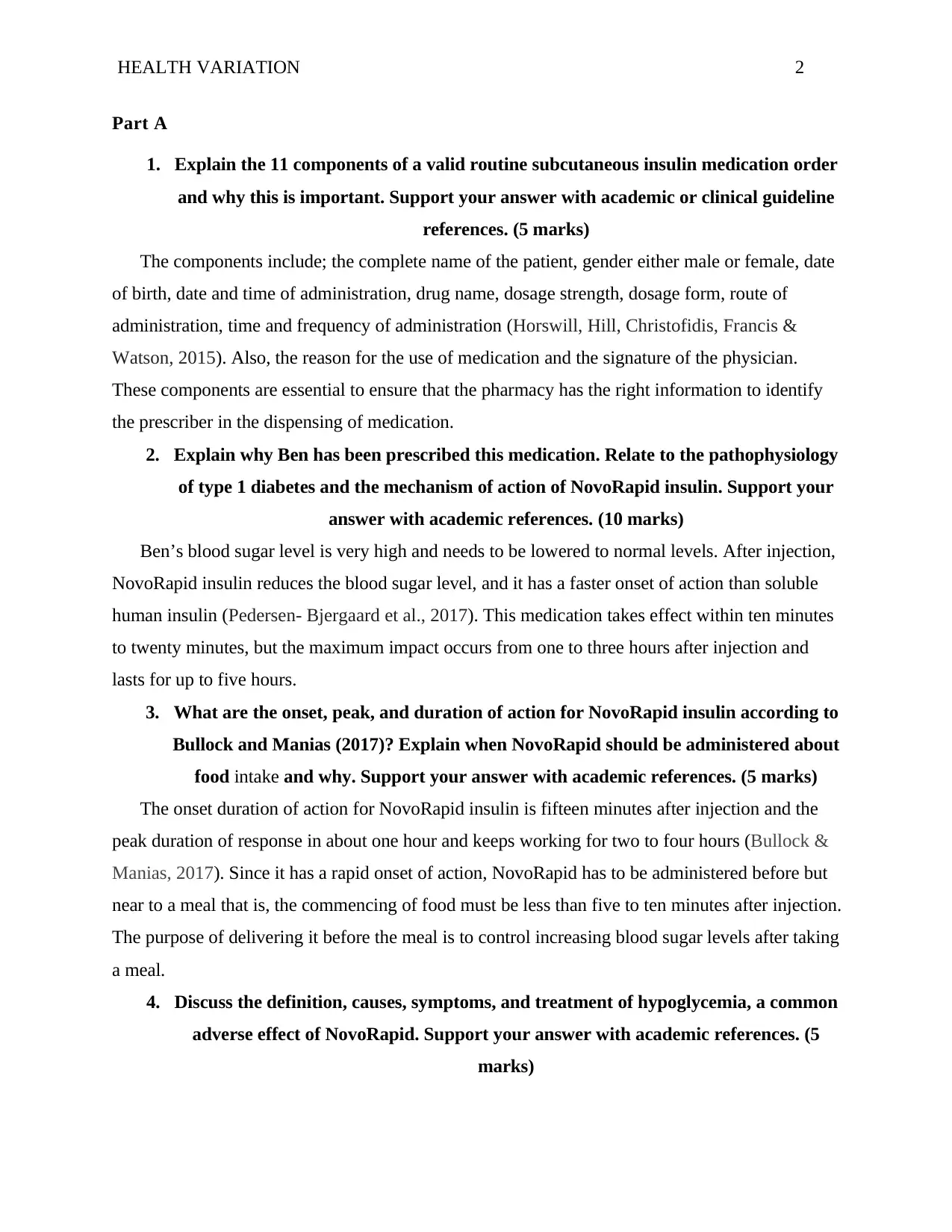
HEALTH VARIATION 2
Part A
1. Explain the 11 components of a valid routine subcutaneous insulin medication order
and why this is important. Support your answer with academic or clinical guideline
references. (5 marks)
The components include; the complete name of the patient, gender either male or female, date
of birth, date and time of administration, drug name, dosage strength, dosage form, route of
administration, time and frequency of administration (Horswill, Hill, Christofidis, Francis &
Watson, 2015). Also, the reason for the use of medication and the signature of the physician.
These components are essential to ensure that the pharmacy has the right information to identify
the prescriber in the dispensing of medication.
2. Explain why Ben has been prescribed this medication. Relate to the pathophysiology
of type 1 diabetes and the mechanism of action of NovoRapid insulin. Support your
answer with academic references. (10 marks)
Ben’s blood sugar level is very high and needs to be lowered to normal levels. After injection,
NovoRapid insulin reduces the blood sugar level, and it has a faster onset of action than soluble
human insulin (Pedersen- Bjergaard et al., 2017). This medication takes effect within ten minutes
to twenty minutes, but the maximum impact occurs from one to three hours after injection and
lasts for up to five hours.
3. What are the onset, peak, and duration of action for NovoRapid insulin according to
Bullock and Manias (2017)? Explain when NovoRapid should be administered about
food intake and why. Support your answer with academic references. (5 marks)
The onset duration of action for NovoRapid insulin is fifteen minutes after injection and the
peak duration of response in about one hour and keeps working for two to four hours (Bullock &
Manias, 2017). Since it has a rapid onset of action, NovoRapid has to be administered before but
near to a meal that is, the commencing of food must be less than five to ten minutes after injection.
The purpose of delivering it before the meal is to control increasing blood sugar levels after taking
a meal.
4. Discuss the definition, causes, symptoms, and treatment of hypoglycemia, a common
adverse effect of NovoRapid. Support your answer with academic references. (5
marks)
Part A
1. Explain the 11 components of a valid routine subcutaneous insulin medication order
and why this is important. Support your answer with academic or clinical guideline
references. (5 marks)
The components include; the complete name of the patient, gender either male or female, date
of birth, date and time of administration, drug name, dosage strength, dosage form, route of
administration, time and frequency of administration (Horswill, Hill, Christofidis, Francis &
Watson, 2015). Also, the reason for the use of medication and the signature of the physician.
These components are essential to ensure that the pharmacy has the right information to identify
the prescriber in the dispensing of medication.
2. Explain why Ben has been prescribed this medication. Relate to the pathophysiology
of type 1 diabetes and the mechanism of action of NovoRapid insulin. Support your
answer with academic references. (10 marks)
Ben’s blood sugar level is very high and needs to be lowered to normal levels. After injection,
NovoRapid insulin reduces the blood sugar level, and it has a faster onset of action than soluble
human insulin (Pedersen- Bjergaard et al., 2017). This medication takes effect within ten minutes
to twenty minutes, but the maximum impact occurs from one to three hours after injection and
lasts for up to five hours.
3. What are the onset, peak, and duration of action for NovoRapid insulin according to
Bullock and Manias (2017)? Explain when NovoRapid should be administered about
food intake and why. Support your answer with academic references. (5 marks)
The onset duration of action for NovoRapid insulin is fifteen minutes after injection and the
peak duration of response in about one hour and keeps working for two to four hours (Bullock &
Manias, 2017). Since it has a rapid onset of action, NovoRapid has to be administered before but
near to a meal that is, the commencing of food must be less than five to ten minutes after injection.
The purpose of delivering it before the meal is to control increasing blood sugar levels after taking
a meal.
4. Discuss the definition, causes, symptoms, and treatment of hypoglycemia, a common
adverse effect of NovoRapid. Support your answer with academic references. (5
marks)
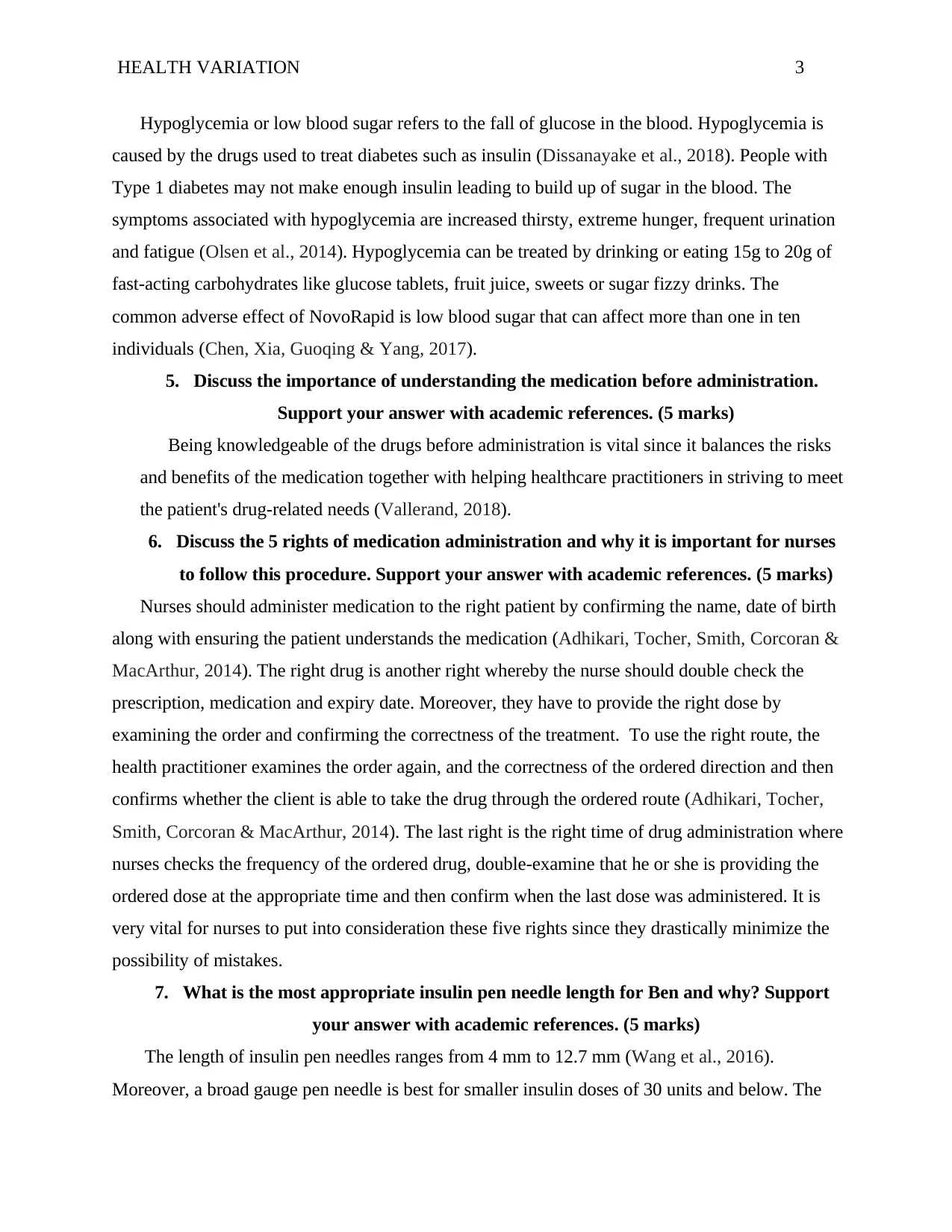
HEALTH VARIATION 3
Hypoglycemia or low blood sugar refers to the fall of glucose in the blood. Hypoglycemia is
caused by the drugs used to treat diabetes such as insulin (Dissanayake et al., 2018). People with
Type 1 diabetes may not make enough insulin leading to build up of sugar in the blood. The
symptoms associated with hypoglycemia are increased thirsty, extreme hunger, frequent urination
and fatigue (Olsen et al., 2014). Hypoglycemia can be treated by drinking or eating 15g to 20g of
fast-acting carbohydrates like glucose tablets, fruit juice, sweets or sugar fizzy drinks. The
common adverse effect of NovoRapid is low blood sugar that can affect more than one in ten
individuals (Chen, Xia, Guoqing & Yang, 2017).
5. Discuss the importance of understanding the medication before administration.
Support your answer with academic references. (5 marks)
Being knowledgeable of the drugs before administration is vital since it balances the risks
and benefits of the medication together with helping healthcare practitioners in striving to meet
the patient's drug-related needs (Vallerand, 2018).
6. Discuss the 5 rights of medication administration and why it is important for nurses
to follow this procedure. Support your answer with academic references. (5 marks)
Nurses should administer medication to the right patient by confirming the name, date of birth
along with ensuring the patient understands the medication (Adhikari, Tocher, Smith, Corcoran &
MacArthur, 2014). The right drug is another right whereby the nurse should double check the
prescription, medication and expiry date. Moreover, they have to provide the right dose by
examining the order and confirming the correctness of the treatment. To use the right route, the
health practitioner examines the order again, and the correctness of the ordered direction and then
confirms whether the client is able to take the drug through the ordered route (Adhikari, Tocher,
Smith, Corcoran & MacArthur, 2014). The last right is the right time of drug administration where
nurses checks the frequency of the ordered drug, double-examine that he or she is providing the
ordered dose at the appropriate time and then confirm when the last dose was administered. It is
very vital for nurses to put into consideration these five rights since they drastically minimize the
possibility of mistakes.
7. What is the most appropriate insulin pen needle length for Ben and why? Support
your answer with academic references. (5 marks)
The length of insulin pen needles ranges from 4 mm to 12.7 mm (Wang et al., 2016).
Moreover, a broad gauge pen needle is best for smaller insulin doses of 30 units and below. The
Hypoglycemia or low blood sugar refers to the fall of glucose in the blood. Hypoglycemia is
caused by the drugs used to treat diabetes such as insulin (Dissanayake et al., 2018). People with
Type 1 diabetes may not make enough insulin leading to build up of sugar in the blood. The
symptoms associated with hypoglycemia are increased thirsty, extreme hunger, frequent urination
and fatigue (Olsen et al., 2014). Hypoglycemia can be treated by drinking or eating 15g to 20g of
fast-acting carbohydrates like glucose tablets, fruit juice, sweets or sugar fizzy drinks. The
common adverse effect of NovoRapid is low blood sugar that can affect more than one in ten
individuals (Chen, Xia, Guoqing & Yang, 2017).
5. Discuss the importance of understanding the medication before administration.
Support your answer with academic references. (5 marks)
Being knowledgeable of the drugs before administration is vital since it balances the risks
and benefits of the medication together with helping healthcare practitioners in striving to meet
the patient's drug-related needs (Vallerand, 2018).
6. Discuss the 5 rights of medication administration and why it is important for nurses
to follow this procedure. Support your answer with academic references. (5 marks)
Nurses should administer medication to the right patient by confirming the name, date of birth
along with ensuring the patient understands the medication (Adhikari, Tocher, Smith, Corcoran &
MacArthur, 2014). The right drug is another right whereby the nurse should double check the
prescription, medication and expiry date. Moreover, they have to provide the right dose by
examining the order and confirming the correctness of the treatment. To use the right route, the
health practitioner examines the order again, and the correctness of the ordered direction and then
confirms whether the client is able to take the drug through the ordered route (Adhikari, Tocher,
Smith, Corcoran & MacArthur, 2014). The last right is the right time of drug administration where
nurses checks the frequency of the ordered drug, double-examine that he or she is providing the
ordered dose at the appropriate time and then confirm when the last dose was administered. It is
very vital for nurses to put into consideration these five rights since they drastically minimize the
possibility of mistakes.
7. What is the most appropriate insulin pen needle length for Ben and why? Support
your answer with academic references. (5 marks)
The length of insulin pen needles ranges from 4 mm to 12.7 mm (Wang et al., 2016).
Moreover, a broad gauge pen needle is best for smaller insulin doses of 30 units and below. The
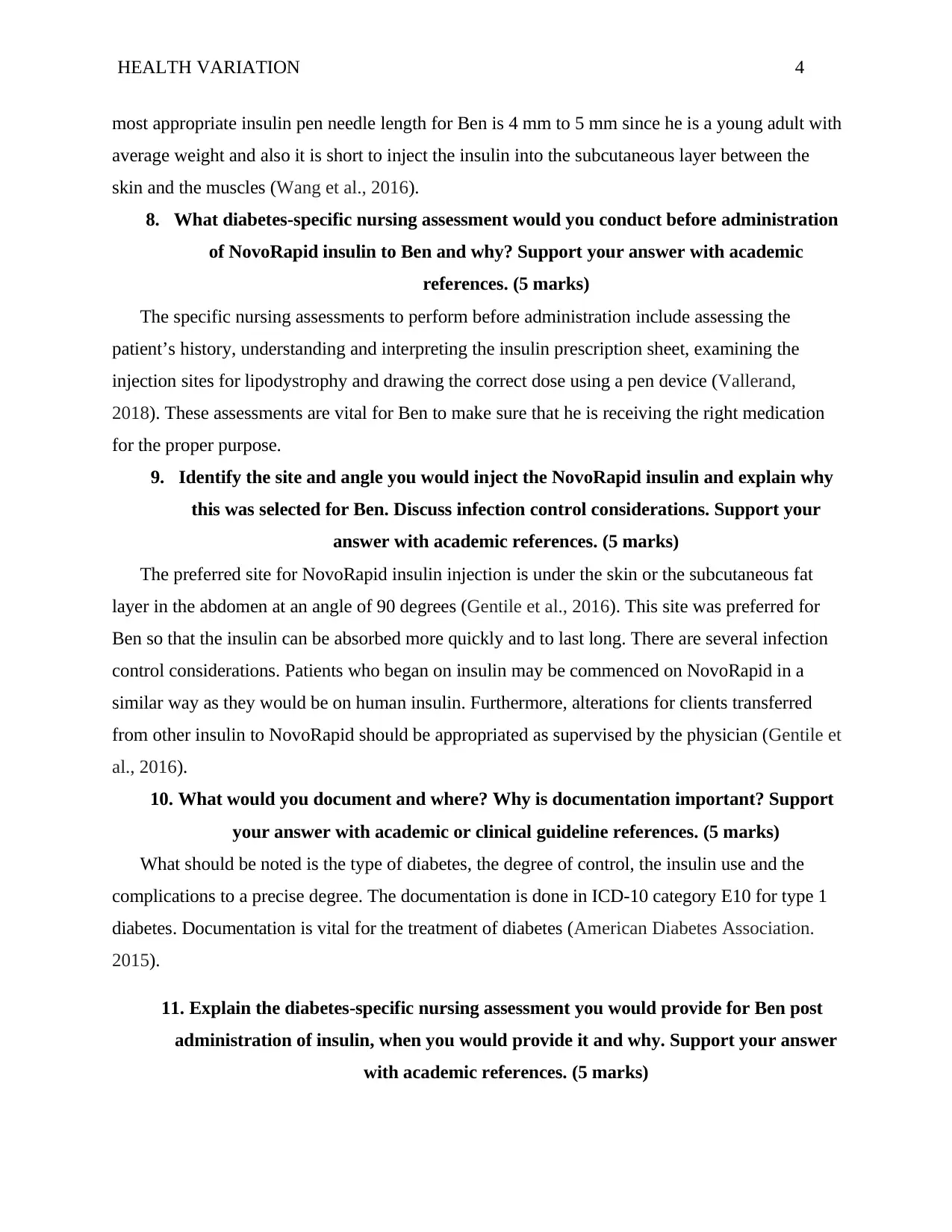
HEALTH VARIATION 4
most appropriate insulin pen needle length for Ben is 4 mm to 5 mm since he is a young adult with
average weight and also it is short to inject the insulin into the subcutaneous layer between the
skin and the muscles (Wang et al., 2016).
8. What diabetes-specific nursing assessment would you conduct before administration
of NovoRapid insulin to Ben and why? Support your answer with academic
references. (5 marks)
The specific nursing assessments to perform before administration include assessing the
patient’s history, understanding and interpreting the insulin prescription sheet, examining the
injection sites for lipodystrophy and drawing the correct dose using a pen device (Vallerand,
2018). These assessments are vital for Ben to make sure that he is receiving the right medication
for the proper purpose.
9. Identify the site and angle you would inject the NovoRapid insulin and explain why
this was selected for Ben. Discuss infection control considerations. Support your
answer with academic references. (5 marks)
The preferred site for NovoRapid insulin injection is under the skin or the subcutaneous fat
layer in the abdomen at an angle of 90 degrees (Gentile et al., 2016). This site was preferred for
Ben so that the insulin can be absorbed more quickly and to last long. There are several infection
control considerations. Patients who began on insulin may be commenced on NovoRapid in a
similar way as they would be on human insulin. Furthermore, alterations for clients transferred
from other insulin to NovoRapid should be appropriated as supervised by the physician (Gentile et
al., 2016).
10. What would you document and where? Why is documentation important? Support
your answer with academic or clinical guideline references. (5 marks)
What should be noted is the type of diabetes, the degree of control, the insulin use and the
complications to a precise degree. The documentation is done in ICD-10 category E10 for type 1
diabetes. Documentation is vital for the treatment of diabetes (American Diabetes Association.
2015).
11. Explain the diabetes-specific nursing assessment you would provide for Ben post
administration of insulin, when you would provide it and why. Support your answer
with academic references. (5 marks)
most appropriate insulin pen needle length for Ben is 4 mm to 5 mm since he is a young adult with
average weight and also it is short to inject the insulin into the subcutaneous layer between the
skin and the muscles (Wang et al., 2016).
8. What diabetes-specific nursing assessment would you conduct before administration
of NovoRapid insulin to Ben and why? Support your answer with academic
references. (5 marks)
The specific nursing assessments to perform before administration include assessing the
patient’s history, understanding and interpreting the insulin prescription sheet, examining the
injection sites for lipodystrophy and drawing the correct dose using a pen device (Vallerand,
2018). These assessments are vital for Ben to make sure that he is receiving the right medication
for the proper purpose.
9. Identify the site and angle you would inject the NovoRapid insulin and explain why
this was selected for Ben. Discuss infection control considerations. Support your
answer with academic references. (5 marks)
The preferred site for NovoRapid insulin injection is under the skin or the subcutaneous fat
layer in the abdomen at an angle of 90 degrees (Gentile et al., 2016). This site was preferred for
Ben so that the insulin can be absorbed more quickly and to last long. There are several infection
control considerations. Patients who began on insulin may be commenced on NovoRapid in a
similar way as they would be on human insulin. Furthermore, alterations for clients transferred
from other insulin to NovoRapid should be appropriated as supervised by the physician (Gentile et
al., 2016).
10. What would you document and where? Why is documentation important? Support
your answer with academic or clinical guideline references. (5 marks)
What should be noted is the type of diabetes, the degree of control, the insulin use and the
complications to a precise degree. The documentation is done in ICD-10 category E10 for type 1
diabetes. Documentation is vital for the treatment of diabetes (American Diabetes Association.
2015).
11. Explain the diabetes-specific nursing assessment you would provide for Ben post
administration of insulin, when you would provide it and why. Support your answer
with academic references. (5 marks)
Secure Best Marks with AI Grader
Need help grading? Try our AI Grader for instant feedback on your assignments.

HEALTH VARIATION 5
The nursing assessments after administration of insulin include disposing used pen needles
safely just after the administration, using a glucometer to monitor BGL and keeping records. All
these assessments should be done quickly after the insulin administration to make sure that he is
put on track of controlling the chronic disease (Vallerand, 2018).
Part B
1. Discuss the daily physical challenges of living with type 1 diabetes that Ben may face.
Support your answer with academic references. (5 marks)
Ben may experience difficulties in insulin administration. Ben will have to procure insulin,
glucometer strips and other treatment facilities from his pocket. In monitoring his blood sugar
level at normal, he must eat foods that do not cause blood sugar spikes and also make sure that he
has enough food and supplies at hand to modify his diet (Baucom et al., 2015). Carbohydrate
counting is a challenge since Ben has to know the foods that contain carbohydrates, estimate the
carbohydrate grams in every meal he eats and adds up the number from every food consumed to
obtain the total for the day (Baucom et al., 2015).
2. Discuss the potential emotional impacts of living with type 1 diabetes that Ben may
face. Support your answer with academic references. (5 marks)
Ben may face diabetes burnout by becoming tired of the daily demands of managing diabetes
hence neglecting or ignoring the day to day management of diabetes. Also, stress affects BGL
directly resulting to its increase since the release of stress hormones like cortisol and adrenaline.
Furthermore, Ben will develop a severe and chronic condition which will affect his mental health
leading to the inability to carry out and enjoy everyday operations (Baucom et al., 2015). Finally,
Ben has a girlfriend called Rachel and he might face negative impacts on quality of life of male
sexual dysfunction.
The nursing assessments after administration of insulin include disposing used pen needles
safely just after the administration, using a glucometer to monitor BGL and keeping records. All
these assessments should be done quickly after the insulin administration to make sure that he is
put on track of controlling the chronic disease (Vallerand, 2018).
Part B
1. Discuss the daily physical challenges of living with type 1 diabetes that Ben may face.
Support your answer with academic references. (5 marks)
Ben may experience difficulties in insulin administration. Ben will have to procure insulin,
glucometer strips and other treatment facilities from his pocket. In monitoring his blood sugar
level at normal, he must eat foods that do not cause blood sugar spikes and also make sure that he
has enough food and supplies at hand to modify his diet (Baucom et al., 2015). Carbohydrate
counting is a challenge since Ben has to know the foods that contain carbohydrates, estimate the
carbohydrate grams in every meal he eats and adds up the number from every food consumed to
obtain the total for the day (Baucom et al., 2015).
2. Discuss the potential emotional impacts of living with type 1 diabetes that Ben may
face. Support your answer with academic references. (5 marks)
Ben may face diabetes burnout by becoming tired of the daily demands of managing diabetes
hence neglecting or ignoring the day to day management of diabetes. Also, stress affects BGL
directly resulting to its increase since the release of stress hormones like cortisol and adrenaline.
Furthermore, Ben will develop a severe and chronic condition which will affect his mental health
leading to the inability to carry out and enjoy everyday operations (Baucom et al., 2015). Finally,
Ben has a girlfriend called Rachel and he might face negative impacts on quality of life of male
sexual dysfunction.
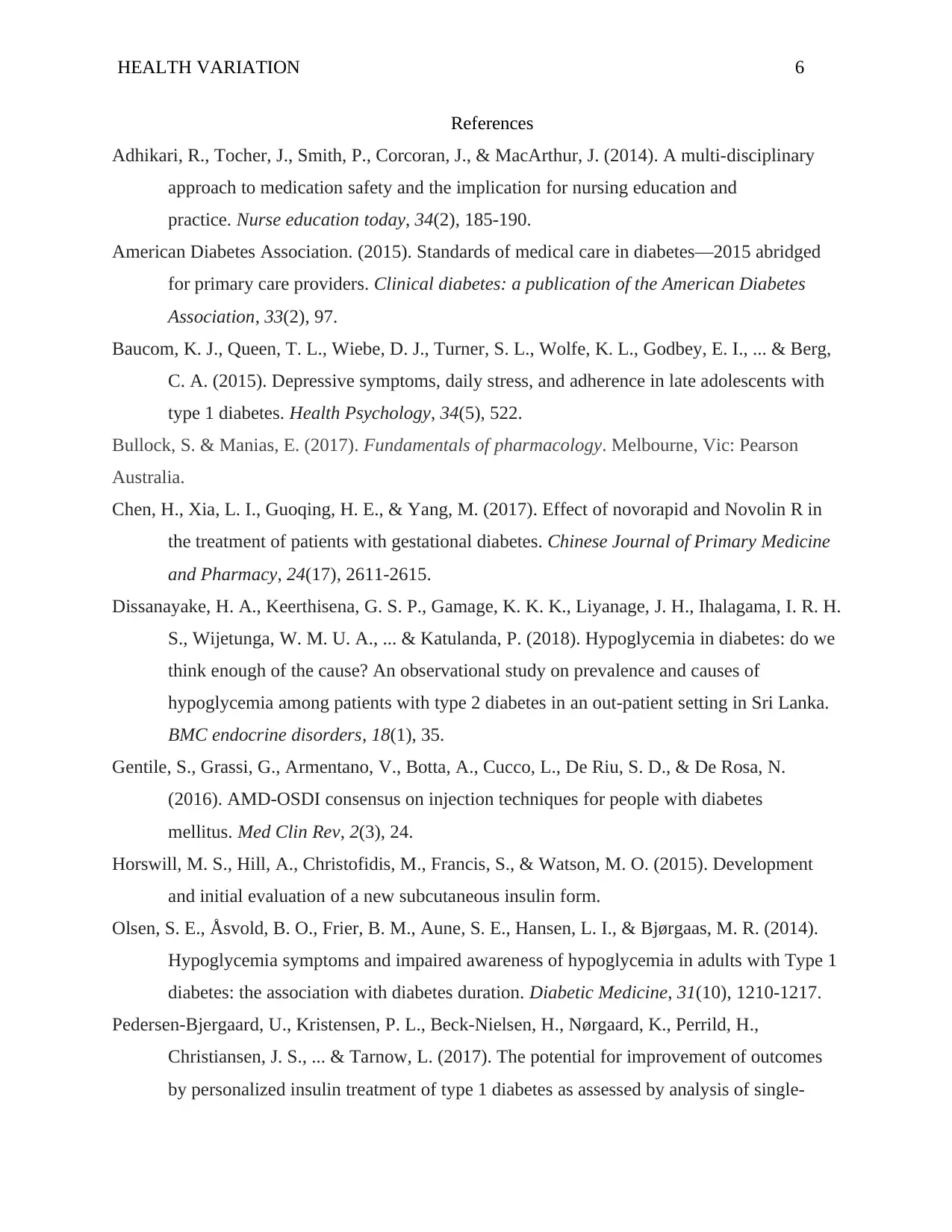
HEALTH VARIATION 6
References
Adhikari, R., Tocher, J., Smith, P., Corcoran, J., & MacArthur, J. (2014). A multi-disciplinary
approach to medication safety and the implication for nursing education and
practice. Nurse education today, 34(2), 185-190.
American Diabetes Association. (2015). Standards of medical care in diabetes—2015 abridged
for primary care providers. Clinical diabetes: a publication of the American Diabetes
Association, 33(2), 97.
Baucom, K. J., Queen, T. L., Wiebe, D. J., Turner, S. L., Wolfe, K. L., Godbey, E. I., ... & Berg,
C. A. (2015). Depressive symptoms, daily stress, and adherence in late adolescents with
type 1 diabetes. Health Psychology, 34(5), 522.
Bullock, S. & Manias, E. (2017). Fundamentals of pharmacology. Melbourne, Vic: Pearson
Australia.
Chen, H., Xia, L. I., Guoqing, H. E., & Yang, M. (2017). Effect of novorapid and Novolin R in
the treatment of patients with gestational diabetes. Chinese Journal of Primary Medicine
and Pharmacy, 24(17), 2611-2615.
Dissanayake, H. A., Keerthisena, G. S. P., Gamage, K. K. K., Liyanage, J. H., Ihalagama, I. R. H.
S., Wijetunga, W. M. U. A., ... & Katulanda, P. (2018). Hypoglycemia in diabetes: do we
think enough of the cause? An observational study on prevalence and causes of
hypoglycemia among patients with type 2 diabetes in an out-patient setting in Sri Lanka.
BMC endocrine disorders, 18(1), 35.
Gentile, S., Grassi, G., Armentano, V., Botta, A., Cucco, L., De Riu, S. D., & De Rosa, N.
(2016). AMD-OSDI consensus on injection techniques for people with diabetes
mellitus. Med Clin Rev, 2(3), 24.
Horswill, M. S., Hill, A., Christofidis, M., Francis, S., & Watson, M. O. (2015). Development
and initial evaluation of a new subcutaneous insulin form.
Olsen, S. E., Åsvold, B. O., Frier, B. M., Aune, S. E., Hansen, L. I., & Bjørgaas, M. R. (2014).
Hypoglycemia symptoms and impaired awareness of hypoglycemia in adults with Type 1
diabetes: the association with diabetes duration. Diabetic Medicine, 31(10), 1210-1217.
Pedersen-Bjergaard, U., Kristensen, P. L., Beck-Nielsen, H., Nørgaard, K., Perrild, H.,
Christiansen, J. S., ... & Tarnow, L. (2017). The potential for improvement of outcomes
by personalized insulin treatment of type 1 diabetes as assessed by analysis of single-
References
Adhikari, R., Tocher, J., Smith, P., Corcoran, J., & MacArthur, J. (2014). A multi-disciplinary
approach to medication safety and the implication for nursing education and
practice. Nurse education today, 34(2), 185-190.
American Diabetes Association. (2015). Standards of medical care in diabetes—2015 abridged
for primary care providers. Clinical diabetes: a publication of the American Diabetes
Association, 33(2), 97.
Baucom, K. J., Queen, T. L., Wiebe, D. J., Turner, S. L., Wolfe, K. L., Godbey, E. I., ... & Berg,
C. A. (2015). Depressive symptoms, daily stress, and adherence in late adolescents with
type 1 diabetes. Health Psychology, 34(5), 522.
Bullock, S. & Manias, E. (2017). Fundamentals of pharmacology. Melbourne, Vic: Pearson
Australia.
Chen, H., Xia, L. I., Guoqing, H. E., & Yang, M. (2017). Effect of novorapid and Novolin R in
the treatment of patients with gestational diabetes. Chinese Journal of Primary Medicine
and Pharmacy, 24(17), 2611-2615.
Dissanayake, H. A., Keerthisena, G. S. P., Gamage, K. K. K., Liyanage, J. H., Ihalagama, I. R. H.
S., Wijetunga, W. M. U. A., ... & Katulanda, P. (2018). Hypoglycemia in diabetes: do we
think enough of the cause? An observational study on prevalence and causes of
hypoglycemia among patients with type 2 diabetes in an out-patient setting in Sri Lanka.
BMC endocrine disorders, 18(1), 35.
Gentile, S., Grassi, G., Armentano, V., Botta, A., Cucco, L., De Riu, S. D., & De Rosa, N.
(2016). AMD-OSDI consensus on injection techniques for people with diabetes
mellitus. Med Clin Rev, 2(3), 24.
Horswill, M. S., Hill, A., Christofidis, M., Francis, S., & Watson, M. O. (2015). Development
and initial evaluation of a new subcutaneous insulin form.
Olsen, S. E., Åsvold, B. O., Frier, B. M., Aune, S. E., Hansen, L. I., & Bjørgaas, M. R. (2014).
Hypoglycemia symptoms and impaired awareness of hypoglycemia in adults with Type 1
diabetes: the association with diabetes duration. Diabetic Medicine, 31(10), 1210-1217.
Pedersen-Bjergaard, U., Kristensen, P. L., Beck-Nielsen, H., Nørgaard, K., Perrild, H.,
Christiansen, J. S., ... & Tarnow, L. (2017). The potential for improvement of outcomes
by personalized insulin treatment of type 1 diabetes as assessed by analysis of single-
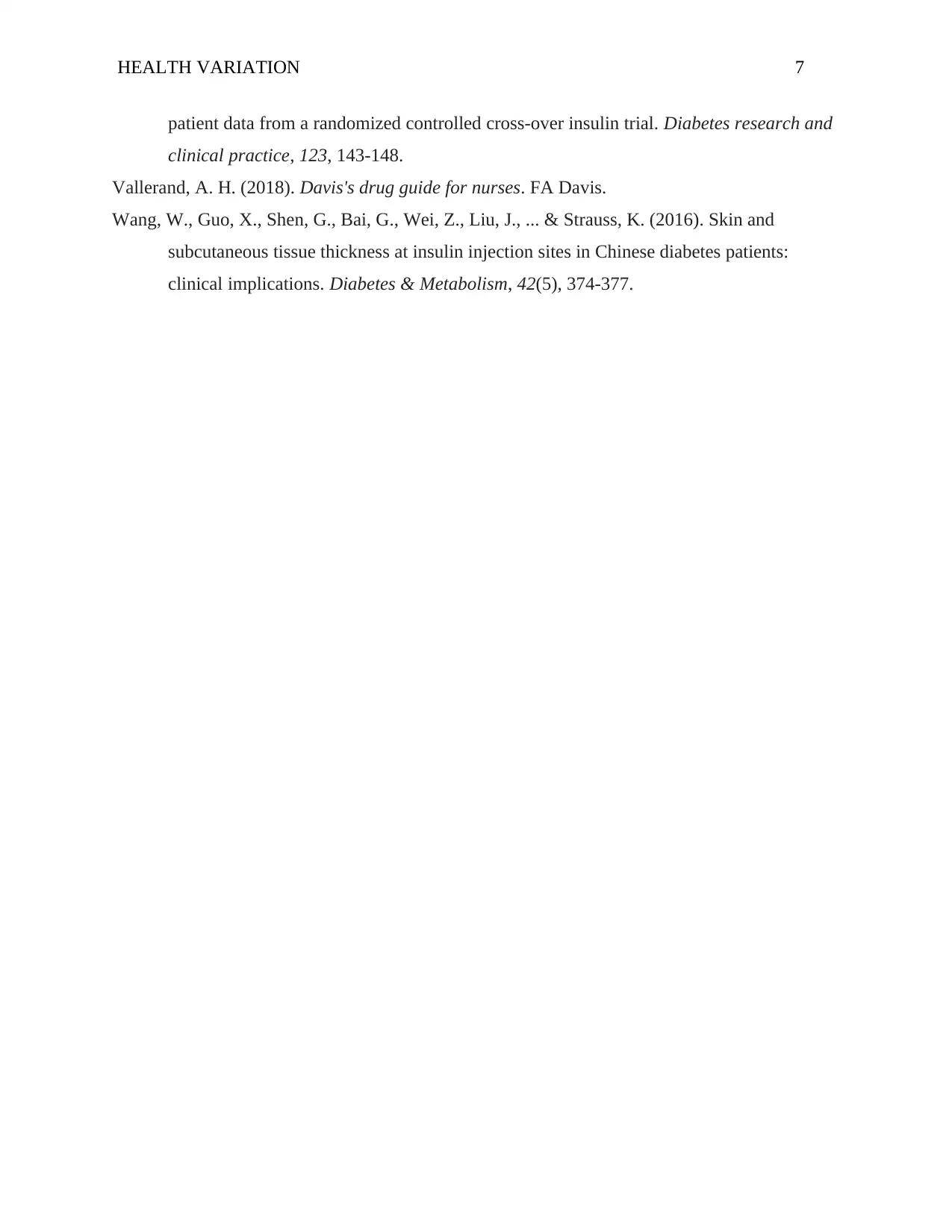
HEALTH VARIATION 7
patient data from a randomized controlled cross-over insulin trial. Diabetes research and
clinical practice, 123, 143-148.
Vallerand, A. H. (2018). Davis's drug guide for nurses. FA Davis.
Wang, W., Guo, X., Shen, G., Bai, G., Wei, Z., Liu, J., ... & Strauss, K. (2016). Skin and
subcutaneous tissue thickness at insulin injection sites in Chinese diabetes patients:
clinical implications. Diabetes & Metabolism, 42(5), 374-377.
patient data from a randomized controlled cross-over insulin trial. Diabetes research and
clinical practice, 123, 143-148.
Vallerand, A. H. (2018). Davis's drug guide for nurses. FA Davis.
Wang, W., Guo, X., Shen, G., Bai, G., Wei, Z., Liu, J., ... & Strauss, K. (2016). Skin and
subcutaneous tissue thickness at insulin injection sites in Chinese diabetes patients:
clinical implications. Diabetes & Metabolism, 42(5), 374-377.
1 out of 7
Related Documents
Your All-in-One AI-Powered Toolkit for Academic Success.
+13062052269
info@desklib.com
Available 24*7 on WhatsApp / Email
![[object Object]](/_next/static/media/star-bottom.7253800d.svg)
Unlock your academic potential
© 2024 | Zucol Services PVT LTD | All rights reserved.





